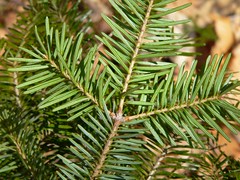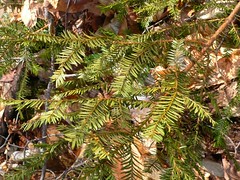arghman
New member
- Joined
- Sep 1, 2004
- Messages
- 1,352
- Reaction score
- 153
I wanted to get back in shape (hadn't been on any hikes more than a mile or two since January) so yesterday (2 Apr 06) hiked Mt Cube from the east, via the AT from NH Rt 25A in Orford. I'd been up Mt Cube from the west (Cross-Rivendell trail) a few years earlier. I didn't pick it for the botany, but rather to get some trailbagging out of the way (another 3 miles of the NH AT! woohoo!).
The AT from the east is a much more interesting trail (not to mention much easier to find the trailhead) & I'd recommend this approach, with the caveat that there is one brook crossing to deal with.
The lower section of the hike goes through a mixed forest of common trees: hemlock, red spruce, fir, sugar maple, beech, red maple, with some pine and hophornbeam in a few spots. Not too interesting but it's a nice walk in the woods.
Brackett Brook was running high enough that I took off my shoes & socks and went across barefoot. Brrrr! Ice cold water, probably much lower than it usually is this time of year from the snowmelt. (there are a few other small stream crossings but they're easy to hop over.)
After you get past the brook, the forest changes to a sugar maple / beech forest which is composed almost completely of hardwoods. This time of year before the leaves come out, you can see for a long ways and it's nice and sunny (in fact I got slightly sunburnt). There were a few spruce and fir trees from time to time, but they were rare and there were stretches of trail where the only green in sight was from ferns and clubmosses.
I did see two yew trees (Taxus canadensis) in different spots, which is the first time I've seen them ever while hiking (oddly enough, the first time I saw them in the "wild" was a few weeks ago in the small woods behind my house, despite having explored the area many times in the 4 1/2 years I've lived there). These are the same species as the manicured hedges you see in landscaping, with the bright red berries that have poisonous seeds. Here in their natural habitat, they are more of a low sprawling shrub that sends branches sticking out every which way but up. They seem to be extremely uncommon (not rare enough to be on the state tracking list, though), and occur fairly solitarily (makes you look at one and think, "Hey, how'd yew get here?" ) rather than in a large colony. Yew and balsam fir (Abies balsamea) branches look somewhat similar; the first clue is the sprawling habit (vs. fir which tends to grow fairly straight... however I've seen fir close to the ground occasionally, probably from deer/moose browse?), but the key if you don't see cones / fruit is to look closely at the branches, esp. the undersides of the needles:
) rather than in a large colony. Yew and balsam fir (Abies balsamea) branches look somewhat similar; the first clue is the sprawling habit (vs. fir which tends to grow fairly straight... however I've seen fir close to the ground occasionally, probably from deer/moose browse?), but the key if you don't see cones / fruit is to look closely at the branches, esp. the undersides of the needles:


The left photo is yew, the right is fir.
Fir needles have those two whitish bands of stomata (pores so the tree can exchange CO2 and O2), whereas the ones on yew needles are hard to see unless you look really closely -- they're a slightly lighter green. The fir branches are a woody, rough gray & the needles are flush with the branch surface -- if you pull off a bunch of needles (preferably do this on a branch that's already broken off; there are plenty this time of year), you're left with a fairly smooth branch, vs. spruce which leaves "pegs" that stick up. Yew needles are attached by a strip that continues on the branches. The younger shoots appear to be green, not woody (though maybe it's just all those strips overlapping), whereas the older, thicker yew branches are kind of a brownish color (see below)

(this lesson was brought to you in part by Doug Weihrauch of AMC and Wink Lees of the Nature Conservancy, who've each given me the scoop on fir & spruce, I think it has finally sunk in; also the Golden Field Guide on trees -- Peterson's guide doesn't mention the white bands are stomata.)
Above 2100ft or so, the spruce & fir start to come back & eventually dominate over the hardwoods, which disappear except for white birch. Thin snow/ice were common above 2400' yesterday. The upper sections of the trail are pretty much your standard spruce/fir forest. I saw bunchberry & goldthread & wood sorrel.
The South Peak has a good view to the south and west; there's also a spur trail (part of the former AT route? the old topo maps show the AT heading north & but the trail now leads east / northeast to 25A) that leads to the North Peak which is definitely worth visiting, for a number of things. The North Peak is on the ledges that you can see from Rt 25A, and the view of Moosilauke & Upper Baker Pond is a good one:

Also the col is slightly boggy & you get that neat-looking red sphagnum moss and sheep laurel and creeping snowberry, a nice little diversion before heading back down.
BTW, does anyone know what species this whatsit plant is? I saw it in a few wet, shaded spots on the trail. Note the hairs on the leaves. I have some thoughts but am unsure of any of them.

Well worth the trip, I may go back (in a future year) so see what's sprouting in that beech/maple forest in the months of May/June.
edit: (4/10/06) ran across more yew twice yesterday, once at our county farm where it was abundant, also at Middlesex Fells (one small 8" sprout on a rocky outcrop), so I guess it's more abundant than I thought.
The AT from the east is a much more interesting trail (not to mention much easier to find the trailhead) & I'd recommend this approach, with the caveat that there is one brook crossing to deal with.
The lower section of the hike goes through a mixed forest of common trees: hemlock, red spruce, fir, sugar maple, beech, red maple, with some pine and hophornbeam in a few spots. Not too interesting but it's a nice walk in the woods.
Brackett Brook was running high enough that I took off my shoes & socks and went across barefoot. Brrrr! Ice cold water, probably much lower than it usually is this time of year from the snowmelt. (there are a few other small stream crossings but they're easy to hop over.)
After you get past the brook, the forest changes to a sugar maple / beech forest which is composed almost completely of hardwoods. This time of year before the leaves come out, you can see for a long ways and it's nice and sunny (in fact I got slightly sunburnt). There were a few spruce and fir trees from time to time, but they were rare and there were stretches of trail where the only green in sight was from ferns and clubmosses.
I did see two yew trees (Taxus canadensis) in different spots, which is the first time I've seen them ever while hiking (oddly enough, the first time I saw them in the "wild" was a few weeks ago in the small woods behind my house, despite having explored the area many times in the 4 1/2 years I've lived there). These are the same species as the manicured hedges you see in landscaping, with the bright red berries that have poisonous seeds. Here in their natural habitat, they are more of a low sprawling shrub that sends branches sticking out every which way but up. They seem to be extremely uncommon (not rare enough to be on the state tracking list, though), and occur fairly solitarily (makes you look at one and think, "Hey, how'd yew get here?"


The left photo is yew, the right is fir.
Fir needles have those two whitish bands of stomata (pores so the tree can exchange CO2 and O2), whereas the ones on yew needles are hard to see unless you look really closely -- they're a slightly lighter green. The fir branches are a woody, rough gray & the needles are flush with the branch surface -- if you pull off a bunch of needles (preferably do this on a branch that's already broken off; there are plenty this time of year), you're left with a fairly smooth branch, vs. spruce which leaves "pegs" that stick up. Yew needles are attached by a strip that continues on the branches. The younger shoots appear to be green, not woody (though maybe it's just all those strips overlapping), whereas the older, thicker yew branches are kind of a brownish color (see below)

(this lesson was brought to you in part by Doug Weihrauch of AMC and Wink Lees of the Nature Conservancy, who've each given me the scoop on fir & spruce, I think it has finally sunk in; also the Golden Field Guide on trees -- Peterson's guide doesn't mention the white bands are stomata.)
Above 2100ft or so, the spruce & fir start to come back & eventually dominate over the hardwoods, which disappear except for white birch. Thin snow/ice were common above 2400' yesterday. The upper sections of the trail are pretty much your standard spruce/fir forest. I saw bunchberry & goldthread & wood sorrel.
The South Peak has a good view to the south and west; there's also a spur trail (part of the former AT route? the old topo maps show the AT heading north & but the trail now leads east / northeast to 25A) that leads to the North Peak which is definitely worth visiting, for a number of things. The North Peak is on the ledges that you can see from Rt 25A, and the view of Moosilauke & Upper Baker Pond is a good one:

Also the col is slightly boggy & you get that neat-looking red sphagnum moss and sheep laurel and creeping snowberry, a nice little diversion before heading back down.
BTW, does anyone know what species this whatsit plant is? I saw it in a few wet, shaded spots on the trail. Note the hairs on the leaves. I have some thoughts but am unsure of any of them.

Well worth the trip, I may go back (in a future year) so see what's sprouting in that beech/maple forest in the months of May/June.
edit: (4/10/06) ran across more yew twice yesterday, once at our county farm where it was abundant, also at Middlesex Fells (one small 8" sprout on a rocky outcrop), so I guess it's more abundant than I thought.
Last edited:
